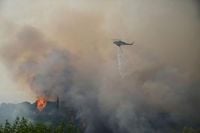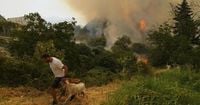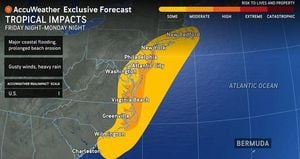Scorching heat, relentless winds, and parched landscapes set the stage for the catastrophic wildfires that swept through Turkey, Greece, and Cyprus during the summer of 2025. According to a new study released on August 28, 2025, by the World Weather Attribution (WWA) group, these fires were not only devastating in scale but also emblematic of a new era: one where climate change is dramatically amplifying the frequency and intensity of such disasters.
The WWA report, conducted by 28 climate scientists and researchers from institutions across Turkey, Greece, the Netherlands, the UK, and the US, found that the weather conditions responsible for the deadly wildfires were about 22% more intense and 10 times more likely than they would have been in a world untouched by man-made climate change. The study, which drew on peer-reviewed methods and rapid attribution analysis, marks the first of its kind for a European wildfire event.
Europe has never seen a wildfire season like this. Over one million hectares (2.47 million acres) of land burned—an area roughly the size of Lebanon—making 2025 the continent’s worst wildfire year on record, as reported by the Associated Press. The blazes broke out in June and July, driven by a relentless combination of factors: temperatures soared above 40 degrees Celsius (104 Fahrenheit), vegetation was bone-dry, and gale-force winds whipped flames across hillsides and through communities.
The human toll was staggering. In total, 20 people lost their lives—Turkey was hit hardest, with 17 fatalities, including 10 firefighters who perished when winds suddenly shifted and trapped them. Cyprus reported two deaths, and Greece one. The fires forced more than 80,000 people to evacuate their homes, scattering families and upending entire communities across the eastern Mediterranean.
But what exactly made this wildfire season so extreme? The WWA study points to a confluence of climate-driven factors. Since the pre-industrial era, the region has experienced a 1.3 degrees Celsius rise in average temperatures. This seemingly modest increase has had outsized effects: the hot, dry, and windy conditions that fueled the fires would have occurred only once every 100 years without climate change. Now, such conditions are expected every 20 years, and if warming continues on its current trajectory, they could become even more frequent.
One of the most striking findings was the drop in winter rainfall—down about 14% compared to pre-industrial times. This reduction left the landscape exceptionally dry and primed for ignition. The study also found that weeklong periods of parched, hot air—perfect for turning forests into tinderboxes—are now 13 times more likely. The intensity of these dry spells has increased by about 18% due to climate change, setting the stage for larger, faster-moving fires.
Wind, too, played a critical role. The WWA analysis identified an increase in the intensity of high-pressure systems that strengthened the region’s notorious northerly Etesian winds. These winds, which once offered firefighters a predictable window to control blazes, have become more erratic and powerful. Gavriil Xanthopoulos, research director at the Institute of Mediterranean Forest Ecosystems in Greece, remarked, “It seems that they cannot count on this pattern anymore.” He noted that more research is needed to understand why these wind patterns are now reaching such high velocities so often.
Theodore Keeping, a researcher at the Centre for Environmental Policy at Imperial College London and one of the report’s authors, expressed deep concern over the findings. “Our study finds an extremely strong climate change signal towards hotter and drier conditions,” he said. “Today, with 1.3 degrees C of warming, we are seeing new extremes in wildfire behaviour that has pushed firefighters to their limit. But we are heading for up to 3 degrees C this century unless countries more rapidly transition away from fossil fuels.”
If global warming reaches 2.6 degrees Celsius—a scenario expected this century if current policies persist—similar periods of intense, hot, dry, and windy conditions will become nine times more likely and 25% more intense, according to the WWA researchers. This paints a sobering picture for the future of Mediterranean summers, where wildfires could become not just more common, but even harder to control.
The impact has not been limited to just Turkey, Greece, and Cyprus. The researchers noted that simultaneous wildfires across Europe this summer have stretched firefighting resources to the breaking point, outpacing even the most ambitious adaptation efforts. As these extreme events multiply, the ability of emergency services to respond effectively is being severely tested.
Flavio Lehner, an assistant professor in Earth and atmospheric sciences at Cornell University who was not involved in the WWA research, weighed in on the results. He told the Associated Press that the study’s summary and key figures were consistent with existing scientific literature and his own understanding of how climate change is “loading the dice for more bad wildfire seasons” in the Mediterranean. In other words, while luck still plays a role in any given year, the odds are increasingly stacked against a calm summer.
The WWA group’s analysis is part of a broader push to understand and communicate the real-time impacts of climate change on extreme weather events. Their work highlights not only the urgent need for emissions reductions but also the growing challenge of adapting to a world where past assumptions about fire seasons no longer hold true. As the researchers continue their studies—including ongoing analyses of recent blazes in Spain—they expect to find similar patterns: climate change is making fire-prone conditions more frequent, more intense, and more dangerous for communities and the emergency workers who protect them.
For now, the message from the scientific community is clear. Unless rapid action is taken to reduce fossil fuel use and limit further warming, summers like 2025 may soon become the norm rather than the exception. The eastern Mediterranean, once renowned for its idyllic landscapes and sun-soaked coasts, now faces a future shaped by fire—a future that will test the resilience of its people, its ecosystems, and its institutions.
As the embers cool and communities begin the long process of recovery, the lessons of this record-breaking fire season will undoubtedly shape debates over climate policy, disaster preparedness, and the urgent need for collective action. The stakes, as this summer has shown, could hardly be higher.





